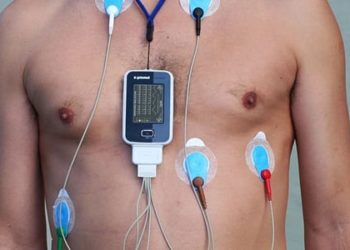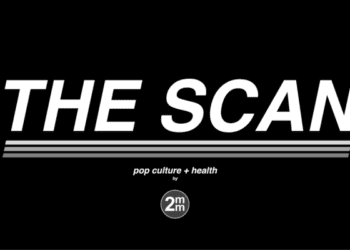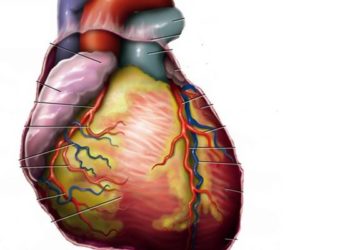2 Minute Medicine Rewind September 21, 2020
1. A workplace intervention that determined employees’ body age was found to decrease body age score, reduce smoking habits, lower risk factors for chronic disease, and lower rates for metabolic syndrome.
Evidence Rating Level: 2 (Good)
As life expectancy in western countries continues to rise, the legislated retirement age is also expected to increase. However, inactive lifestyles contributing to obesity and other health conditions are barriers to a robust and healthy aging workforce. The workplace is a potential setting for a public health intervention, since employees would be expected to share similar lifestyles, socioeconomic status, and other social determinants of health. An intervention growing in popularity is a health risk assessment involving body-age estimates: Essentially, body-age is a combination of all risk factors to determine an individual’s susceptibility to poor health and disease. It is a simple number to interpret: For optimal health, one’s body age should be equal to or lower than one’s actual age. The current retrospective study from Denmark evaluated the effectiveness of a body-age based intervention (BAI) in the workplace. The BAI involved a health screening within working hours, a report with body-age score and what factors contributed to it, and a motivational interview (MI) to promote health behaviour changes. The follow-up was variable, with a median of 1.3 years and interquartile range of 1.0-2.1 years. At the follow-up, the health outcomes measured were changes in body age score, smoking habits, single risk factors, and metabolic syndrome. In total, 90 companies participated, with 3,843 employees undergoing both the BAI and the follow-up. The study found that body age decreased, with a drop of 0.6 years (95% CI -0.7 to -0.5) for men and 0.7 years (95% CI -0.8 to -0.5) for women (P < 0.001). As well, 42% of smokers had quit smoking by the follow-up and 19% had reduced their smoking, although 21% increased smoking and 18% had no change. For single risk factors, there was higher HDL (0.02 mmol/l) and lower LDL (-0.06 mmol/l) in women. In men and women, there were no changes in glucose concentration or blood pressure, but lower BMI, weight, body fat percent, and waist circumference. Lastly, the number of employees with metabolic syndrome decreased from 16.8% to 14.5%. Overall, this study demonstrates how a BAI and MI can be effectively implemented in the workplace, with impacts on numerous areas of health for both the individual employee and for the aging workforce.
Association of sleep quality and sleep duration with serum uric acid levels in adults
1. Short sleep duration was associated with high uric acid levels, whereas poor sleep quality was associated with low uric acid levels.
Evidence Rating Level: 2 (Good)
A proper balance of uric acid levels is vital to one’s health, because of its role in antioxidation and neuroprotection. Hyperuricemia affects 20% of people worldwide, and is related to conditions such as gout, chronic kidney disease, and cardiovascular disease, as well as early mortality. However, low uric acid is also related to diseases such as Alzheimer’s and Parkinson’s. Both sleep quality and duration are thought to influence uric acid levels, but previous literature has not studied this association with both sleep factors simultaneously, and the same sample population. The current study from Taiwan examines the correlation between these sleep factors and uric acid levels. The sample included 4,592 adult patients who self-opted for a general health assessment at a university hospital. Sleep duration was assessed as short (< 7 hours), normal (7-9 hours), or long (>9 hours). Sleep quality was assessed using the self-evaluated Pittsburgh Sleep Quality Index (PSQI), which looks at factors such as sleep duration, percent of time spent asleep while in bed, time taken to fall asleep, sleep medication use, and sleep disturbances. The study found that poor quality sleepers were associated with lower uric acid levels (correlation coefficient -0.085, 95% CI -0.161—0.008, P = 0.030). As well, those with short sleep durations were associated with high uric acid levels (correlation coefficient 0.106, 95% CI 0.31-0.181, P = 0.006). Overall, this study elucidates how different sleep factors can be associated with both high and low uric acid levels, as well as provides potential support for guidelines directed at patients with uric acid imbalance.
1. An opportunistic screening protocol for atrial fibrillation was not found to improve diagnostic rates, compared to usual care.
Evidence Rating Level: 1 (Excellent)
Atrial fibrillation (AF) is a cardiac arrhythmia that increases in prevalence with age. AF can also lead to cardiovascular conditions such as stroke and heart failure. Although the symptoms are well-known, such as shortness of breath, palpitations, and dizziness, AF can also appear asymptomatic at times, or occur as unpredictable flare-ups. This underlies the importance of effective AF screening and early detection. Still, only 1 other randomized controlled trial was conducted on the effects of AF screening and diagnosis, showing that opportunistic screening led to more diagnoses than usual care. However, this study was done in 2007, and technological advances in screening have been made since then, such as handheld electrocardiographic devices. The current study was a 1-year randomized controlled trial in the Netherlands, comparing AF diagnoses with opportunistic screening versus usual care. The study population included 17,976 patients aged 65 and over, from 96 primary care practices in the country; each practice was randomized into one of the two groups, stratified by the existing number of AF patients in the practice. The opportunistic group screened any primary care patient with one or more positive index tests (pulse palpation, electronic blood pressure monitor, or hand electrocardiograph), as well as randomly screening patients with negative results for all 3 tests. In the study, 45% of eligible patients were screened through the opportunistic protocol. Usual care may have differed for each physician in the study, but national guidelines suggested assessing heart rhythm in any patient presenting with AF symptoms. The study found that 1.62% of patients in the opportunistic group were newly diagnosed with AF, compared to 1.53% of patients in the usual care group. This was not a significant difference (Odds Ratio 1.06, 95% CI 0.84-1.35, P = 0.60). Therefore, an opportunistic screening protocol did not impact AF diagnostic rates, which highlights the need for exploring other methods to diagnose patients early, such as through targeted screening or heart rhythm monitoring through common wireless devices.
Life’s Simple 7 and Incident Hypertension: The REGARDS Study
1. A 6% risk reduction for developing hypertension was associated with a 1-point improvement in Life’s Simple 7 score, a metric for cardiovascular health.
Evidence Rating Level: 2 (Good)
Hypertension is a condition that affects roughly half of the adult US population, and is a known risk factor for cardiovascular disease (CVD), stroke, and numerous other health concerns. Although behaviours that are associated with better cardiovascular health (CVH) appear to lower blood pressure, such as exercise and weight loss, the relationship between CVH and hypertension risk is not well-researched. For instance, only one study in the US was conducted to investigate the correlation between hypertension risk and Life’s Simple 7 score (LS7), a metric developed by the American Heart Association to measure CVH. The aforementioned study investigated only Black adults and used a blood pressure of 140/90 mm Hg as the threshold for hypertension. Therefore, the current cohort study aimed to study both White and Black adults, and use a hypertension threshold of 130/80 mm Hg, as defined by the American Heart Association in 2017. Individuals on hypertension medication were also grouped as meeting this threshold. In the study, CVH was determined using the LS7 score, which measures body mass index, physical activity, diet, cigarette smoking, blood pressure, cholesterol levels, and glucose levels. Each factor was given a score of 0, 1, or 2, so that an LS7 score of 14 would indicate the best CVH. Overall, there were 2,930 participants in the study, 20% Black. When first enrolled between 2003 and 2007, all participants had normal blood pressure. At the follow-up between 2013 and 2016, 41% had developed hypertension (52% and 50% incidence for Black women and men, 37% and 42% incidence for White women and men). After controlling for all covariates, a 1-point increase in LS7 score was associated with 6% lower risk for hypertension (Risk Ratio 0.94, 95% CI 0.92-0.96). As well, no significant differences were found when categorizing by race or sex (P = 0.18 and 0.14 respectively). In conclusion, improved CVH was found to lower risk of developing hypertension, which lends support to guidelines that use the components of the LS7 metric to prevent or mitigate hypertension.
1. A computerized model predicted that 64.6% of Canadians will be infected with SARS-CoV-2 without any interventions.
2. With enhanced case detection and contact tracing, infection rate was predicted to be 0.4%, and 0.2% if sustained physical distancing was additionally achieved.
3. Keeping infection rate under 0.2% was the only scenario that kept all ICU’s under capacity, prevented all deaths, and eliminated the epidemic.
Evidence Rating Level: 2 (Good)
Six months have passed since the World Health Organization declared COVID-19 a pandemic. In these past months, Canada’s public health response has involved the following four measures: Detecting and isolating symptomatic cases, tracing contacts and quarantining exposed individuals, physical distancing measures, and closure of community spaces. However, because this level of response is unprecedented in recent times, it is unclear to what extent each of these measures is effective. The current study used a computer simulation to predict which combination of measures would be best for minimizing transmission. An agent-based model was used: Agents can represent a heterogeneous group of people, with each agent possessing unique characteristics. This allows for an element of randomness to influence the events in the simulation. The model extended from May 2020 to January 2022, comparing 4 possible combinations of interventions: Case detection and contact tracing at enhanced levels or baseline levels (from data collected between February 2020 and May 2020), paired with either maintenance of physical distancing or no physical distancing. Each scenario was then combined with community closures to determine their significance. The model predicted that with no interventions, the total attack rate (percentage of Canadians infected) would be 64.6%, with a 95% credible interval (CrI) of 63.9%-65.0%. With no physical distancing combined with baseline levels of case detection and contact tracing, the total attack rate would be 56.1% (95% CrI 0.05-57.1%), but with enhanced levels, it would be 0.4% (95% CrI 0.03%-23.5%). The deaths per 100,000 were 1113 (95% CrI 0-1208) and 739 (95% CrI 0-830) respectively. The best scenario was adding physical distancing to enhanced levels, dropping the attack rate to 0.2% (95% CrI 0.03%-1.7%) and deaths per 100,000 to 4 (95% CrI 0-296). As well, this was the only scenario where hospital and ICU bed capacity were consistently not exceeded, and the epidemic was eliminated in all realizations of the simulation. In terms of community closures, school closures were not seen to be as effective compared to closing workplaces and mixed-age venues, which have higher infection rates. Overall, this study has implications for guiding Canada’s continued response to COVID-19, with greater levels of detection and tracing needed, as well as maintained physical distancing, in order to minimize transmission and eventually eliminate the epidemic.
Image: PD
©2020 2 Minute Medicine, Inc. All rights reserved. No works may be reproduced without expressed written consent from 2 Minute Medicine, Inc. Inquire about licensing here. No article should be construed as medical advice and is not intended as such by the authors or by 2 Minute Medicine, Inc.







